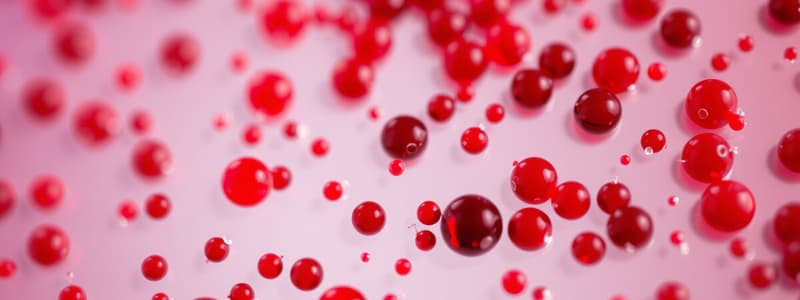Podcast
Questions and Answers
What is the main liquid component of blood and its approximate percentage by weight?
What is the main liquid component of blood and its approximate percentage by weight?
- Electrolytes - 75%
- Serum - 90%
- Plasma - 93% (correct)
- Albumin - 85%
What is the normal pH range of blood?
What is the normal pH range of blood?
- 7.5 - 8.0
- 7.35 - 7.45 (correct)
- 6.0 - 6.9
- 7.0 - 7.2
Which factor can lead to misleading results in blood collection?
Which factor can lead to misleading results in blood collection?
- Resting for at least 30 minutes before collection
- Excessive physical activity before collection (correct)
- Hydrating with water right before drawing blood
- Having a balanced meal two hours prior
What is a preferred site for skin puncture blood sampling in adults?
What is a preferred site for skin puncture blood sampling in adults?
What is the specific gravity of normal blood?
What is the specific gravity of normal blood?
Which component is not considered a formed element of blood?
Which component is not considered a formed element of blood?
During blood collection, how does hemoconcentration affect the sample?
During blood collection, how does hemoconcentration affect the sample?
What percentage of whole blood in an adult male is typically made up of red blood cells?
What percentage of whole blood in an adult male is typically made up of red blood cells?
Which group of patients is most suitable for micro sample collection due to their vein conditions?
Which group of patients is most suitable for micro sample collection due to their vein conditions?
What is the preferred length of a lancet used for micro sample collection to avoid penetrating the bone?
What is the preferred length of a lancet used for micro sample collection to avoid penetrating the bone?
Which type of device is NOT commonly used for micro sample collection?
Which type of device is NOT commonly used for micro sample collection?
Which puncturing device is a short and stout needle designed specifically for micro sample collection?
Which puncturing device is a short and stout needle designed specifically for micro sample collection?
Which of the following is NOT a suitable equipment for micro sample collection?
Which of the following is NOT a suitable equipment for micro sample collection?
Flashcards are hidden until you start studying
Study Notes
Blood Composition
- Adult males have 5-6 liters of whole blood; adult females have 4-5 liters.
- Blood is comprised of 55% liquid (plasma) and 45% formed elements (cells).
- Plasma consists of 93% water and 7% solids (proteins and albumins).
- Solid components include RBCs (2.25 L, 45%), WBCs (0.037 L, 1.6%), and platelets (0.0065 L).
Physical Characteristics of Blood
- Blood is a fluid state in vivo due to heparin presence.
- It appears red due to hemoglobin content.
- Slightly alkaline with a pH range of 7.35-7.45, influenced by bicarbonates, CO2, electrolytes, and proteins.
- Specific gravity averages at 1.055, within the range of 1.045-1.065.
- Blood is thick and viscous, 3.5 to 4.5 times thicker than water, and has a salty taste from plasma electrolytes.
Blood Collection and Handling
- It's essential to record protein names for sample identification.
- Patients should fast for at least 12 hours to maintain accurate WBC counts.
- Blood extraction is recommended between 8:00 and 9:00 AM after patient rest.
- Misleading results can occur due to pre-collection factors (recent meals, smoking, physical activity, stress) or collection/handling errors (diurnal variance, posture changes, hemoconcentration, incorrect anticoagulant use).
Methods of Blood Collection
- Blood can be obtained via skin puncture, venipuncture, or arterial puncture.
Skin Puncture
- Collects a mixture of arterial and venous blood, primarily arteriolar in origin.
- Contains interstitial and intracellular fluids, with PCV, RBC count, and Hgb slightly higher than in venous blood.
- Higher leukocyte and neutrophil counts by 8%, and monocyte count by 12% compared to venous blood.
- Platelet counts are lower due to adherence at the puncture site.
Preferred Sites for Skin Puncture
- Palmar surface of the 3rd or 4th finger.
- Lateral plantar heel surface for newborns.
- Plantar surface of the big toe.
- Margin of the earlobe (least preferred site).
Application of Micro Sample Collection
- Suitable for infants under 6 months, young children, adults with poor veins, or patients with thrombotic tendencies.
Equipment for Micro Sample Collection
- Appropriate capillary tubes (Caraway pipette, heparinized or plain capillary, Sarstedt system).
- Microtainers and Unopettes.
- Becton Dickinson microtainer for blood collection.
Puncturing Devices
- Needles such as Glover's needle (3-cornered, short) and Hagedorn needle (large with cord).
- Blades like Bard Parker Blade #1 or scalpel blades.
- Additional devices include lancets, glass capillary pricker, pin, and cork pricker.
- A lancet length of 1.75 mm is preferred to avoid penetrating the bone; depth of incision should be controlled.
Studying That Suits You
Use AI to generate personalized quizzes and flashcards to suit your learning preferences.




